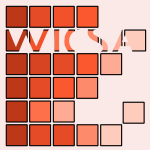85 papers:
 CHI-2015-VatavuW #analysis #elicitation #formal method #metric #tool support
CHI-2015-VatavuW #analysis #elicitation #formal method #metric #tool support- Formalizing Agreement Analysis for Elicitation Studies: New Measures, Significance Test, and Toolkit (RDV, JOW), pp. 1325–1334.
 DUXU-UI-2015-SahitoCHHS #tablet
DUXU-UI-2015-SahitoCHHS #tablet- Significance of Line Length for Tablet PC Users (WAS, HIC, ZH, SRH, FS), pp. 587–596.
 ECIR-2015-Dutta #approximate #mining #named #statistics #string #using
ECIR-2015-Dutta #approximate #mining #named #statistics #string #using- MIST: Top-k Approximate Sub-string Mining Using Triplet Statistical Significance (SD), pp. 284–290.
 KDD-2015-Llinares-LopezS #mining #mutation testing #performance #permutation #testing
KDD-2015-Llinares-LopezS #mining #mutation testing #performance #permutation #testing- Fast and Memory-Efficient Significant Pattern Mining via Permutation Testing (FLL, MS, LP, KMB), pp. 725–734.
 ICSE-v1-2015-ZouWXZSM #algorithm #detection #float #search-based
ICSE-v1-2015-ZouWXZSM #algorithm #detection #float #search-based- A Genetic Algorithm for Detecting Significant Floating-Point Inaccuracies (DZ, RW, YX, LZ, ZS, HM), pp. 529–539.
 PPoPP-2015-VassiliadisPCALBVN #energy #programming #runtime
PPoPP-2015-VassiliadisPCALBVN #energy #programming #runtime- A programming model and runtime system for significance-aware energy-efficient computing (VV, KP, CC, CDA, SL, NB, HV, DSN), pp. 275–276.
 SIGMOD-2014-AroraSB #graph #mining #statistics
SIGMOD-2014-AroraSB #graph #mining #statistics- Mining statistically significant connected subgraphs in vertex labeled graphs (AA, MS, AB), pp. 1003–1014.
 SCAM-2014-Abi-AntounCVG #abstract interpretation #graph #question #using
SCAM-2014-Abi-AntounCVG #abstract interpretation #graph #question #using- Are Object Graphs Extracted Using Abstract Interpretation Significantly Different from the Code? (MAA, SC, RV, AG), pp. 245–254.
 SCSM-2014-LeonardoFGPSSUWC #identification #social #social media #trust
SCSM-2014-LeonardoFGPSSUWC #identification #social #social media #trust- Identifying Locations of Social Significance: Aggregating Social Media Content to Create a New Trust Model for Exploring Crowd Sourced Data and Information (ADL, SF, AG, FP, WS, TS, AU, DW, JBC), pp. 170–177.
 CIKM-2014-LiuLK #classification #information management #performance #using
CIKM-2014-LiuLK #classification #information management #performance #using- Using Local Information to Significantly Improve Classification Performance (WL, DL, RK), pp. 1947–1950.
 KDD-2014-SchubertWK #detection #named #scalability #topic
KDD-2014-SchubertWK #detection #named #scalability #topic- SigniTrend: scalable detection of emerging topics in textual streams by hashed significance thresholds (ES, MW, HPK), pp. 871–880.
 SIGIR-2014-Carterette #information retrieval #statistics #testing #theory and practice
SIGIR-2014-Carterette #information retrieval #statistics #testing #theory and practice- Statistical significance testing in information retrieval: theory and practice (BC), p. 1286.
 SAC-2014-AlharbiZ #predict #social
SAC-2014-AlharbiZ #predict #social- Exploring the significance of human mobility patterns in social link prediction (BA, XZ), pp. 604–609.
 FSE-2014-MirakhorliFGWC #architecture #detection #monitoring #named
FSE-2014-MirakhorliFGWC #architecture #detection #monitoring #named- Archie: a tool for detecting, monitoring, and preserving architecturally significant code (MM, AF, AG, MW, JCH), pp. 739–742.
 ICDAR-2013-ClausnerPA #documentation #evaluation #order #recognition
ICDAR-2013-ClausnerPA #documentation #evaluation #order #recognition- The Significance of Reading Order in Document Recognition and Its Evaluation (CC, SP, AA), pp. 688–692.
 CSEET-2013-DebGG #case study #experience #re-engineering #social
CSEET-2013-DebGG #case study #experience #re-engineering #social- Software engineering projects with social significance: An experience report at a minority university (DD, LG, MG), pp. 314–318.
 HIMI-HSM-2013-Wesugi #approach #design #experience #novel #simulation
HIMI-HSM-2013-Wesugi #approach #design #experience #novel #simulation- Design Approach of Simulation Exercise with Use of Device and Its Significance — Design of Novel Device for Realistic Experience of Being a Hemiplegia Patient (SW), pp. 315–324.
 SIGIR-2013-UrbanoMM13a #comparison #evaluation #information retrieval #statistics #testing
SIGIR-2013-UrbanoMM13a #comparison #evaluation #information retrieval #statistics #testing- A comparison of the optimality of statistical significance tests for information retrieval evaluation (JU, MM, DM), pp. 925–928.
 REFSQ-2013-Cleland-HuangCK #agile #approach #architecture #requirements
REFSQ-2013-Cleland-HuangCK #agile #approach #architecture #requirements- A Persona-Based Approach for Exploring Architecturally Significant Requirements in Agile Projects (JCH, AC, EK), pp. 18–33.
 ICLP-J-2013-MazuranSZ #datalog #declarative #horn clause
ICLP-J-2013-MazuranSZ #datalog #declarative #horn clause- A declarative extension of horn clauses, and its significance for datalog and its applications (MM, ES, CZ), pp. 609–623.
 SIGMOD-2012-MongioviBRSPF #mining #named #network
SIGMOD-2012-MongioviBRSPF #mining #named #network- SigSpot: mining significant anomalous regions from time-evolving networks (abstract only) (MM, PB, RR, AKS, EEP, CF), p. 865.
 VLDB-2012-SachanB #mining #statistics #string #using
VLDB-2012-SachanB #mining #statistics #string #using- Mining Statistically Significant Substrings using the Chi-Square Statistic (MS, AB), pp. 1052–1063.
 ICPR-2012-Berrar #classification #comparison #null #testing #visual notation
ICPR-2012-Berrar #classification #comparison #null #testing #visual notation- Null QQ plots: A simple graphical alternative to significance testing for the comparison of classifiers (DPB), pp. 1852–1855.
 KDD-2012-KawaleCOSLK #testing
KDD-2012-KawaleCOSLK #testing- Testing the significance of spatio-temporal teleconnection patterns (JK, SC, DO, KS, SL, VK), pp. 642–650.
 KDIR-2012-Martiny #security
KDIR-2012-Martiny #security- Unsupervised Discovery of Significant Candlestick Patterns for Forecasting Security Price Movements (KM), pp. 145–150.
 KDIR-2012-QuirogaMH #sequence
KDIR-2012-QuirogaMH #sequence- Frequent and Significant Episodes in Sequences of Events — Computation of a New Frequency Measure based on Individual Occurrences of the Events (OQ, JM, SH), pp. 324–328.
 MoDELS-2012-PfeifferW #development
MoDELS-2012-PfeifferW #development- Cross-Language Support Mechanisms Significantly Aid Software Development (RHP, AW), pp. 168–184.
 MoDELS-2012-PfeifferW #development
MoDELS-2012-PfeifferW #development- Cross-Language Support Mechanisms Significantly Aid Software Development (RHP, AW), pp. 168–184.
 LICS-2012-Parys #on the
LICS-2012-Parys #on the- On the Significance of the Collapse Operation (PP), pp. 521–530.
 WICSA-2011-MiksovicZ #architecture #information management #metamodelling #requirements
WICSA-2011-MiksovicZ #architecture #information management #metamodelling #requirements- Architecturally Significant Requirements, Reference Architecture, and Metamodel for Knowledge Management in Information Technology Services (CM, OZ), pp. 270–279.
 DAC-2011-KarakonstantisBATGR
DAC-2011-KarakonstantisBATGR- Significance driven computation on next-generation unreliable platforms (GK, NB, CDA, GT, VG, KR), pp. 290–291.
 HT-2011-TakahashiOYIOT #analysis #using #wiki
HT-2011-TakahashiOYIOT #analysis #using #wiki- Evaluating significance of historical entities based on tempo-spatial impacts analysis using Wikipedia link structure (YT, HO, MY, HI, SO, KT), pp. 83–92.
 ICALP-v1-2011-FortnowS #robust #simulation
ICALP-v1-2011-FortnowS #robust #simulation- Robust Simulations and Significant Separations (LF, RS), pp. 569–580.
 ICSE-2011-Mirakhorli #approach #architecture #requirements
ICSE-2011-Mirakhorli #approach #architecture #requirements- Tracing architecturally significant requirements: a decision-centric approach (MM), pp. 1126–1127.
 VLDB-2010-CaoCJ10a #mining #semantics
VLDB-2010-CaoCJ10a #mining #semantics- Mining Significant Semantic Locations From GPS Data (XC, GC, CSJ), pp. 1009–1020.
 CSMR-2010-OzkayaPGC #architecture #evolution #requirements #using
CSMR-2010-OzkayaPGC #architecture #evolution #requirements #using- Using Architecturally Significant Requirements for Guiding System Evolution (IO, JADP, AG, SC), pp. 127–136.
 ECIR-2010-RedpathGMC #collaboration #recommendation
ECIR-2010-RedpathGMC #collaboration #recommendation- Collaborative Filtering: The Aim of Recommender Systems and the Significance of User Ratings (JR, DHG, SIM, LC), pp. 394–406.
 ICPR-2010-BharathM #empirical #on the #online #recognition #word
ICPR-2010-BharathM #empirical #on the #online #recognition #word- On the Significance of Stroke Size and Position for Online Handwritten Devanagari Word Recognition: An Empirical Study (AB, SM), pp. 2033–2036.
 KDD-2010-FangNF
KDD-2010-FangNF- Discovering significant relaxed order-preserving submatrices (QF, WN, JF), pp. 433–442.
 KDD-2010-GoorhaU #roadmap
KDD-2010-GoorhaU #roadmap- Discovery of significant emerging trends (SG, LHU), pp. 57–64.
 KDIR-2010-KleizaKT #approach #documentation #identification #query #semantics #similarity #visualisation #word
KDIR-2010-KleizaKT #approach #documentation #identification #query #semantics #similarity #visualisation #word- Semantic Identification and Visualization of Significant Words within Documents — Approach to Visualize Relevant Words within Documents to a Search Query by Word Similarity Computation (KK, PK, KDT), pp. 481–486.
 HPDC-2010-AgrawalMHC #estimation #named #parallel #sequence #statistics
HPDC-2010-AgrawalMHC #estimation #named #parallel #sequence #statistics- MPIPairwiseStatSig: parallel pairwise statistical significance estimation of local sequence alignment (AA, SM, DH, ANC), pp. 470–476.
 IJCAR-2010-AbourbihBBM #automation #calculus
IJCAR-2010-AbourbihBBM #automation #calculus- A Single-Significant-Digit Calculus for Semi-Automated Guesstimation (JAA, LB, AB, FM), pp. 354–368.
 PODS-2009-KirschMPPUV #approach #identification #performance #statistics
PODS-2009-KirschMPPUV #approach #identification #performance #statistics- An efficient rigorous approach for identifying statistically significant frequent itemsets (AK, MM, AP, GP, EU, FV), pp. 117–126.
 CIKM-2009-AnWZH #database #scalability
CIKM-2009-AnWZH #database #scalability- Diverging patterns: discovering significant frequency change dissimilarities in large databases (AA, QW, JZ, XH), pp. 1473–1476.
 SIGIR-2009-SmuckerAC #evaluation #information retrieval #statistics #testing
SIGIR-2009-SmuckerAC #evaluation #information retrieval #statistics #testing- Agreement among statistical significance tests for information retrieval evaluation at varying sample sizes (MDS, JA, BC), pp. 630–631.
 SIGMOD-2008-YanCHY #graph #mining
SIGMOD-2008-YanCHY #graph #mining- Mining significant graph patterns by leap search (XY, HC, JH, PSY), pp. 433–444.
 CIKM-2008-AlqadahB08a #clustering #detection #set
CIKM-2008-AlqadahB08a #clustering #detection #set- Detecting significant distinguishing sets among bi-clusters (FA, RB), pp. 1455–1456.
 KDD-2008-MoiseS #approach #clustering #novel #statistics
KDD-2008-MoiseS #approach #clustering #novel #statistics- Finding non-redundant, statistically significant regions in high dimensional data: a novel approach to projected and subspace clustering (GM, JS), pp. 533–541.
 SAC-2008-YuB #detection #effectiveness #multi #performance
SAC-2008-YuB #detection #effectiveness #multi #performance- A fast and effective method to detect multiple least significant bits steganography (XY, NB), pp. 1443–1447.
 ITiCSE-2007-RavehHY #student
ITiCSE-2007-RavehHY #student- Transforming a high school student project in computer science into a significant scientific achievement (BR, BH, CY), p. 331.
 CIAA-2007-Supol
CIAA-2007-Supol- Significant Subpatterns Matching (JS), pp. 317–319.
 ICEIS-AIDSS-2007-Calvo-FloresNGF07a #empirical
ICEIS-AIDSS-2007-Calvo-FloresNGF07a #empirical- An Empirical Study of Significant Variables for Trading Strategies (MDCF, JFNN, EGG, CMF), pp. 330–335.
 CIKM-2007-SmuckerAC #comparison #evaluation #information retrieval #statistics #testing
CIKM-2007-SmuckerAC #comparison #evaluation #information retrieval #statistics #testing- A comparison of statistical significance tests for information retrieval evaluation (MDS, JA, BC), pp. 623–632.
 ICSM-2006-RompaeyBD #smell
ICSM-2006-RompaeyBD #smell- Characterizing the Relative Significance of a Test Smell (BVR, BDB, SD), pp. 391–400.
 EDOC-2006-HosslerBS #modelling
EDOC-2006-HosslerBS #modelling- Significant Productivity Enhancement through Model Driven Techniques: A Success Story (JH, MB, SS), pp. 367–373.
 ICPR-v2-2006-ClimentS #segmentation #visual notation
ICPR-v2-2006-ClimentS #segmentation #visual notation- Visually Significant Dynamics for Watershed Segmentation (JC, AS), pp. 341–344.
 KDD-2006-GaoGEJ #clustering
KDD-2006-GaoGEJ #clustering- Discovering significant OPSM subspace clusters in massive gene expression data (BJG, OLG, ME, SJMJ), pp. 922–928.
 KDD-2006-Webb
KDD-2006-Webb- Discovering significant rules (GIW), pp. 434–443.
 ISSTA-2006-KiviluomaKM #architecture #aspect-oriented #behaviour #monitoring #runtime #using
ISSTA-2006-KiviluomaKM #architecture #aspect-oriented #behaviour #monitoring #runtime #using- Run-time monitoring of architecturally significant behaviors using behavioral profiles and aspects (KK, JK, TM), pp. 181–190.
 SAC-2005-Morimoto #mining #transitive
SAC-2005-Morimoto #mining #transitive- Optimized transitive association rule: mining significant stopover between events (YM), pp. 543–544.
 DAC-2004-GoldmanKBBBCSV #question #statistics
DAC-2004-GoldmanKBBBCSV #question #statistics- Is statistical timing statistically significant? (RG, KK, CB, AB, SYB, EC, LS, CV), p. 498.
 ITiCSE-2004-ChesnevarGM #automaton #formal method #learning
ITiCSE-2004-ChesnevarGM #automaton #formal method #learning- Didactic strategies for promoting significant learning in formal languages and automata theory (CIC, MPG, AGM), pp. 7–11.
 ICML-2004-JakulinB #interactive #testing
ICML-2004-JakulinB #interactive #testing- Testing the significance of attribute interactions (AJ, IB).
 ICPR-v4-2004-TothSWA #clustering #detection #using
ICPR-v4-2004-TothSWA #clustering #detection #using- Detection of Moving Shadows using Mean Shift Clustering and a Significance Test (DT, IS, AW, TA), pp. 260–263.
 KDD-2004-NeillM #agile #clustering #detection
KDD-2004-NeillM #agile #clustering #detection- Rapid detection of significant spatial clusters (DBN, AWM), pp. 256–265.
 KDD-2004-ZhangPT #on the #statistics
KDD-2004-ZhangPT #on the #statistics- On the discovery of significant statistical quantitative rules (HZ, BP, AT), pp. 374–383.
 ICML-2003-KotnikK #learning #self
ICML-2003-KotnikK #learning #self- The Significance of Temporal-Difference Learning in Self-Play Training TD-Rummy versus EVO-rummy (CK, JKK), pp. 369–375.
 KDD-2003-TaoMF #framework #mining #using
KDD-2003-TaoMF #framework #mining #using- Weighted Association Rule Mining using weighted support and significance framework (FT, FM, MMF), pp. 661–666.
 ICSE-2003-InoueYFYMK #component #rank
ICSE-2003-InoueYFYMK #component #rank- Component Rank: Relative Significance Rank for Software Component Search (KI, RY, HF, TY, MM, SK), pp. 14–24.
 ICPR-v2-2002-Maloof #analysis #machine learning #on the #statistics #testing
ICPR-v2-2002-Maloof #analysis #machine learning #on the #statistics #testing- On Machine Learning, ROC Analysis, and Statistical Tests of Significance (MAM), pp. 204–207.
 ICML-2001-LatinneSD #classification #multi #problem
ICML-2001-LatinneSD #classification #multi #problem- Adjusting the Outputs of a Classifier to New a Priori Probabilities May Significantly Improve Classification Accuracy: Evidence from a multi-class problem in remote sensing (PL, MS, CD), pp. 298–305.
 SAC-2001-ZhouCH #correlation #identification #optimisation #problem #set #using
SAC-2001-ZhouCH #correlation #identification #optimisation #problem #set #using- Identifying the most significant pairwise correlations of residues in different positions of helices: the subset selection problem using least squares optimization (XZ, GC, MTH), pp. 51–55.
 ICPR-v3-2000-VassZ #analysis #component #fault #image #performance
ICPR-v3-2000-VassZ #analysis #component #fault #image #performance- Enhanced Significance-Linked Connected Component Analysis for High Performance Error Resilient Wavelet Image Coding (JV, XZ), pp. 3075–3078.
 KR-2000-BesnardS
KR-2000-BesnardS- Significant Inferences : Preliminary Report (PB, TS), pp. 401–410.
 ITiCSE-1999-Szejko #quality
ITiCSE-1999-Szejko #quality- An exercise in evaluating significance of software quality criteria (SS), p. 199.
 CIKM-1999-SwanA
CIKM-1999-SwanA- Extracting Significant Time Varying Features from Text (RCS, JA), pp. 38–45.
 ICPR-1996-Garcia-SilventeFG #approach #image #multi
ICPR-1996-Garcia-SilventeFG #approach #image #multi- A multi-channel-based approach for extracting significant scales on gray-level images (MGS, JFV, JAG), pp. 231–235.
 ICPR-1996-Kupeev #algorithm #detection #on the
ICPR-1996-Kupeev #algorithm #detection #on the- On significant maxima detection: a fine-to-coarse algorithm (KYK), pp. 270–274.
 ICPR-1996-ModayurS #3d #statistics #using
ICPR-1996-ModayurS #3d #statistics #using- 3D matching using statistically significant groupings (BRM, LGS), pp. 238–242.
 KDD-1994-BhandariB #data analysis #on the #statistics
KDD-1994-BhandariB #data analysis #on the #statistics- On the Role of Statistical Significance in Exploratory Data Analysis (ISB, SB), pp. 61–72.
 ML-1992-MuggletonSB
ML-1992-MuggletonSB- Compression, Significance, and Accuracy (SM, AS, MB), pp. 338–347.
 SIGIR-1991-Cleverdon #testing
SIGIR-1991-Cleverdon #testing- The Significance of the Cranfield Tests on Index Languages (CWC), pp. 3–12.
 ML-1989-GamsK #empirical #learning
ML-1989-GamsK #empirical #learning- New Empirical Learning Mechanisms Perform Significantly Better in Real Life Domains (MG, AK), pp. 99–103.
 HCI-SES-1987-Watanabe #architecture #automation #interface
HCI-SES-1987-Watanabe #architecture #automation #interface- Human-Interface Architecture: Its Significance for Office Automation System (HW), pp. 279–294.
 CHI-2015-VatavuW #analysis #elicitation #formal method #metric #tool support
CHI-2015-VatavuW #analysis #elicitation #formal method #metric #tool support DUXU-UI-2015-SahitoCHHS #tablet
DUXU-UI-2015-SahitoCHHS #tablet ECIR-2015-Dutta #approximate #mining #named #statistics #string #using
ECIR-2015-Dutta #approximate #mining #named #statistics #string #using KDD-2015-Llinares-LopezS #mining #mutation testing #performance #permutation #testing
KDD-2015-Llinares-LopezS #mining #mutation testing #performance #permutation #testing ICSE-v1-2015-ZouWXZSM #algorithm #detection #float #search-based
ICSE-v1-2015-ZouWXZSM #algorithm #detection #float #search-based PPoPP-2015-VassiliadisPCALBVN #energy #programming #runtime
PPoPP-2015-VassiliadisPCALBVN #energy #programming #runtime SIGMOD-2014-AroraSB #graph #mining #statistics
SIGMOD-2014-AroraSB #graph #mining #statistics SCAM-2014-Abi-AntounCVG #abstract interpretation #graph #question #using
SCAM-2014-Abi-AntounCVG #abstract interpretation #graph #question #using SCSM-2014-LeonardoFGPSSUWC #identification #social #social media #trust
SCSM-2014-LeonardoFGPSSUWC #identification #social #social media #trust CIKM-2014-LiuLK #classification #information management #performance #using
CIKM-2014-LiuLK #classification #information management #performance #using KDD-2014-SchubertWK #detection #named #scalability #topic
KDD-2014-SchubertWK #detection #named #scalability #topic SIGIR-2014-Carterette #information retrieval #statistics #testing #theory and practice
SIGIR-2014-Carterette #information retrieval #statistics #testing #theory and practice SAC-2014-AlharbiZ #predict #social
SAC-2014-AlharbiZ #predict #social FSE-2014-MirakhorliFGWC #architecture #detection #monitoring #named
FSE-2014-MirakhorliFGWC #architecture #detection #monitoring #named ICDAR-2013-ClausnerPA #documentation #evaluation #order #recognition
ICDAR-2013-ClausnerPA #documentation #evaluation #order #recognition CSEET-2013-DebGG #case study #experience #re-engineering #social
CSEET-2013-DebGG #case study #experience #re-engineering #social HIMI-HSM-2013-Wesugi #approach #design #experience #novel #simulation
HIMI-HSM-2013-Wesugi #approach #design #experience #novel #simulation SIGIR-2013-UrbanoMM13a #comparison #evaluation #information retrieval #statistics #testing
SIGIR-2013-UrbanoMM13a #comparison #evaluation #information retrieval #statistics #testing REFSQ-2013-Cleland-HuangCK #agile #approach #architecture #requirements
REFSQ-2013-Cleland-HuangCK #agile #approach #architecture #requirements ICLP-J-2013-MazuranSZ #datalog #declarative #horn clause
ICLP-J-2013-MazuranSZ #datalog #declarative #horn clause SIGMOD-2012-MongioviBRSPF #mining #named #network
SIGMOD-2012-MongioviBRSPF #mining #named #network VLDB-2012-SachanB #mining #statistics #string #using
VLDB-2012-SachanB #mining #statistics #string #using ICPR-2012-Berrar #classification #comparison #null #testing #visual notation
ICPR-2012-Berrar #classification #comparison #null #testing #visual notation KDD-2012-KawaleCOSLK #testing
KDD-2012-KawaleCOSLK #testing KDIR-2012-Martiny #security
KDIR-2012-Martiny #security KDIR-2012-QuirogaMH #sequence
KDIR-2012-QuirogaMH #sequence MoDELS-2012-PfeifferW #development
MoDELS-2012-PfeifferW #development MoDELS-2012-PfeifferW #development
MoDELS-2012-PfeifferW #development LICS-2012-Parys #on the
LICS-2012-Parys #on the WICSA-2011-MiksovicZ #architecture #information management #metamodelling #requirements
WICSA-2011-MiksovicZ #architecture #information management #metamodelling #requirements DAC-2011-KarakonstantisBATGR
DAC-2011-KarakonstantisBATGR HT-2011-TakahashiOYIOT #analysis #using #wiki
HT-2011-TakahashiOYIOT #analysis #using #wiki ICALP-v1-2011-FortnowS #robust #simulation
ICALP-v1-2011-FortnowS #robust #simulation ICSE-2011-Mirakhorli #approach #architecture #requirements
ICSE-2011-Mirakhorli #approach #architecture #requirements VLDB-2010-CaoCJ10a #mining #semantics
VLDB-2010-CaoCJ10a #mining #semantics CSMR-2010-OzkayaPGC #architecture #evolution #requirements #using
CSMR-2010-OzkayaPGC #architecture #evolution #requirements #using ECIR-2010-RedpathGMC #collaboration #recommendation
ECIR-2010-RedpathGMC #collaboration #recommendation ICPR-2010-BharathM #empirical #on the #online #recognition #word
ICPR-2010-BharathM #empirical #on the #online #recognition #word KDD-2010-FangNF
KDD-2010-FangNF KDD-2010-GoorhaU #roadmap
KDD-2010-GoorhaU #roadmap KDIR-2010-KleizaKT #approach #documentation #identification #query #semantics #similarity #visualisation #word
KDIR-2010-KleizaKT #approach #documentation #identification #query #semantics #similarity #visualisation #word HPDC-2010-AgrawalMHC #estimation #named #parallel #sequence #statistics
HPDC-2010-AgrawalMHC #estimation #named #parallel #sequence #statistics IJCAR-2010-AbourbihBBM #automation #calculus
IJCAR-2010-AbourbihBBM #automation #calculus PODS-2009-KirschMPPUV #approach #identification #performance #statistics
PODS-2009-KirschMPPUV #approach #identification #performance #statistics CIKM-2009-AnWZH #database #scalability
CIKM-2009-AnWZH #database #scalability SIGIR-2009-SmuckerAC #evaluation #information retrieval #statistics #testing
SIGIR-2009-SmuckerAC #evaluation #information retrieval #statistics #testing SIGMOD-2008-YanCHY #graph #mining
SIGMOD-2008-YanCHY #graph #mining CIKM-2008-AlqadahB08a #clustering #detection #set
CIKM-2008-AlqadahB08a #clustering #detection #set KDD-2008-MoiseS #approach #clustering #novel #statistics
KDD-2008-MoiseS #approach #clustering #novel #statistics SAC-2008-YuB #detection #effectiveness #multi #performance
SAC-2008-YuB #detection #effectiveness #multi #performance ITiCSE-2007-RavehHY #student
ITiCSE-2007-RavehHY #student CIAA-2007-Supol
CIAA-2007-Supol ICEIS-AIDSS-2007-Calvo-FloresNGF07a #empirical
ICEIS-AIDSS-2007-Calvo-FloresNGF07a #empirical CIKM-2007-SmuckerAC #comparison #evaluation #information retrieval #statistics #testing
CIKM-2007-SmuckerAC #comparison #evaluation #information retrieval #statistics #testing ICSM-2006-RompaeyBD #smell
ICSM-2006-RompaeyBD #smell EDOC-2006-HosslerBS #modelling
EDOC-2006-HosslerBS #modelling ICPR-v2-2006-ClimentS #segmentation #visual notation
ICPR-v2-2006-ClimentS #segmentation #visual notation KDD-2006-GaoGEJ #clustering
KDD-2006-GaoGEJ #clustering KDD-2006-Webb
KDD-2006-Webb ISSTA-2006-KiviluomaKM #architecture #aspect-oriented #behaviour #monitoring #runtime #using
ISSTA-2006-KiviluomaKM #architecture #aspect-oriented #behaviour #monitoring #runtime #using SAC-2005-Morimoto #mining #transitive
SAC-2005-Morimoto #mining #transitive DAC-2004-GoldmanKBBBCSV #question #statistics
DAC-2004-GoldmanKBBBCSV #question #statistics ITiCSE-2004-ChesnevarGM #automaton #formal method #learning
ITiCSE-2004-ChesnevarGM #automaton #formal method #learning ICML-2004-JakulinB #interactive #testing
ICML-2004-JakulinB #interactive #testing ICPR-v4-2004-TothSWA #clustering #detection #using
ICPR-v4-2004-TothSWA #clustering #detection #using KDD-2004-NeillM #agile #clustering #detection
KDD-2004-NeillM #agile #clustering #detection KDD-2004-ZhangPT #on the #statistics
KDD-2004-ZhangPT #on the #statistics ICML-2003-KotnikK #learning #self
ICML-2003-KotnikK #learning #self KDD-2003-TaoMF #framework #mining #using
KDD-2003-TaoMF #framework #mining #using ICSE-2003-InoueYFYMK #component #rank
ICSE-2003-InoueYFYMK #component #rank ICPR-v2-2002-Maloof #analysis #machine learning #on the #statistics #testing
ICPR-v2-2002-Maloof #analysis #machine learning #on the #statistics #testing ICML-2001-LatinneSD #classification #multi #problem
ICML-2001-LatinneSD #classification #multi #problem SAC-2001-ZhouCH #correlation #identification #optimisation #problem #set #using
SAC-2001-ZhouCH #correlation #identification #optimisation #problem #set #using ICPR-v3-2000-VassZ #analysis #component #fault #image #performance
ICPR-v3-2000-VassZ #analysis #component #fault #image #performance KR-2000-BesnardS
KR-2000-BesnardS ITiCSE-1999-Szejko #quality
ITiCSE-1999-Szejko #quality CIKM-1999-SwanA
CIKM-1999-SwanA ICPR-1996-Garcia-SilventeFG #approach #image #multi
ICPR-1996-Garcia-SilventeFG #approach #image #multi ICPR-1996-Kupeev #algorithm #detection #on the
ICPR-1996-Kupeev #algorithm #detection #on the ICPR-1996-ModayurS #3d #statistics #using
ICPR-1996-ModayurS #3d #statistics #using KDD-1994-BhandariB #data analysis #on the #statistics
KDD-1994-BhandariB #data analysis #on the #statistics ML-1992-MuggletonSB
ML-1992-MuggletonSB SIGIR-1991-Cleverdon #testing
SIGIR-1991-Cleverdon #testing ML-1989-GamsK #empirical #learning
ML-1989-GamsK #empirical #learning HCI-SES-1987-Watanabe #architecture #automation #interface
HCI-SES-1987-Watanabe #architecture #automation #interface









